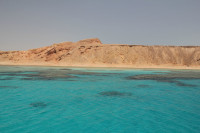Travel
Napoléon Bonapatre and his conquest of Egypt
220 years ago ended Napoléon’s conquest of Egypt.
Success or failure? Historians have different opinions on the matter. What sure is that after that an Egypt mania started in France and Egyptian treasures started gaining world exposure. The Rosetta stone, found during the French Expedition, helped providing the missing clues to understand and read hieroglyphics.
Let’s look at what happened during the French time in Egypt:
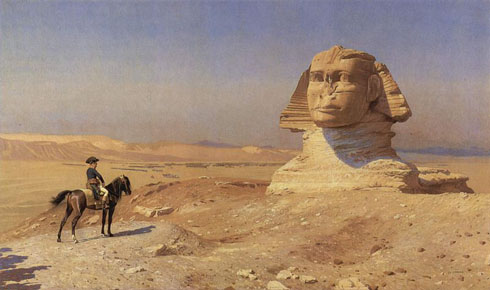
Bonapatre before the Sphinx – painter J-Léon Gérome 1867-8
Time frame: 38 months 1798-1801
Napoléon Bonaparte left Toulon on May 20th 1798 and arrived in Alexandria on July 1st. The French army stayed there until October 1801 after the capitulation (31st of August).
Why did Napoleon want to conquer Egypt? What were his goals?
- to gain more territory for France and have Egypt become a French colony
- to explore the country, map it and learn everything about Ancient Egypt.
- to free the Egyptians from the Mamluks (Turkish soldiers, formally slaves)
- to teach them what they knew
- to have a canal in Suez
- to have the trading road to India
Who approved the departure?
It was approved by the Directorate (French government during the 1st French Republic). Maurice Talleyrand, Foreign minister, at the time also approved this decision, after hearing the positive opinion of Charles Magellon, French consul in Cairo.
Who left on this expedition?
About 54,000 people, of which only 400 women, were on the ships. They were 36,800 army men, 160 surgeons and other health personnel. Bonaparte brought with him numerous artists, painters, astronomers, botanists, scholars like Alexandre Dumas, geologists, zoologists, engineers, architects, etc…
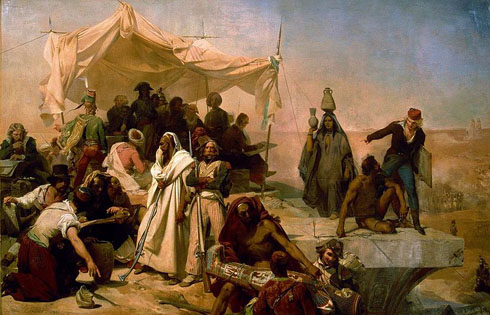
The French in Egypt – Painter Léon Cogniet (1835)
How did they leave and what did they bring?
They left on a fleet of over 300 boats. Some ships were for merchandise, people and there were also frigates. Only a few people knew the end destination. It was kept a secret so that the British don’t go after them.
They brought 1250 horses and 170 canons. Something Napoléon did not forget was wine: he brought over 4800 bottles of wine with him.
Who were the three important figures leading the expedition?
Napoléon did not stay during the entire expedition in Egypt. In October 1799 he returned to France. Some say he deserted the French army. During his time in Egypt he established new reforms and taxes. He also set up a regiment of dromedaries when the army started lacking in horses (Jan. 1799).
When Napoléon Bonaparte left, General Jean-Baptiste Kléber took over the commands. He was stabbed on June 14th, 1800 by Suleimann al Halabi, a student of Syrian origin. Kléber was different than Napoléon. He wanted the French to leave Egypt. According to historian, Robert Solé, Kléber was not like Bonaparte “the messenger from God, but the absolute master”.
He was replaced by General Abdallah Menou. For him it was important to stay in Egypt and for Egypt to become a French colony. He stayed until the capitulation of the French army on August 31st, 1801. Menou created new taxes to raise money for the war.
What was difficult for the French in Egypt?
- heat, burning sand
- mosquitoes
- dogs in Cairo
- scorpion bites
- suffered from scorbutic, ophthalmia, dysentery
- loneliness, had to adjust to the new culture
- not being well accepted in Egypt
What did the French do to forget and feel more like at home?
They opened some cafés in Cairo, some public baths, smoked hashish and visited prostitutes. Some married Egyptian women or hired slaves to help them in their daily tasks.
What did they die the most of?
Research shows that during the months from July 1798 to Sept 1800, that venereal diseases were a cause of death almost as much as dying in combat: 2411 deaths (disease) against 3561 (combat).
As well one awful disease causing the deaths of many Frenchmen was the Plague. Some had to take opium to relieve the pain.
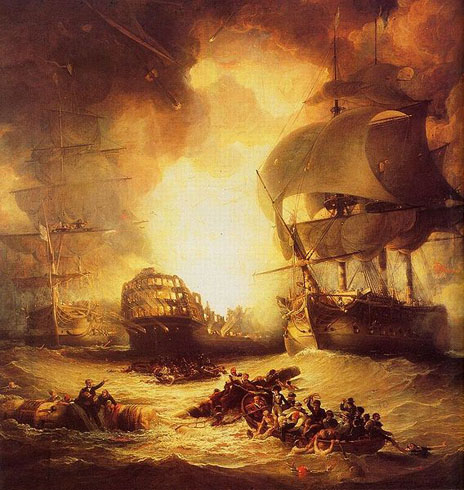
Aboukir Battle by George Arnal (1820’s)
When were the most well-known battles and who won them?
- On July 2d, 1798, the French took the port of Alexandria.
- Battle of the Nile: French did not debut well in Egypt. They lost their first battle against the British with Admiral Nelson in August 1798. It was a complete naval disaster. The French lost almost all of their battle ships. One talks about an “apocalypse” with a loss of 1700 people.
- Battle of the Pyramids: Napoléon won against the chef of the Mamluks, Ibrahim Bey.
- Battles of Mount Tabor in Palestine & Syria: happened in April 1799. There was a massacre in Jaffa.
- Battle of Aboukir: in July 1799, French won against the Turks. 10,000 Turks drowned.
- Battle of Heliopolis: victory against the Turks in the Spring of 1800. During that battle the French are now allied with the Mamluks.
- Battle of Aboukir & Alexandria: in March 1801, the French army lost against the British
- Violent riots in Cairo against the French: October 1798, 250 French were killed and more than 2500 Cairo citizen.
- Siege of Cairo in April 1800
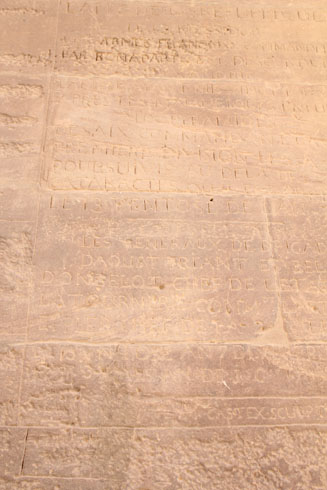
French notes in Philae temple in Assuan
What did the French accomplish in Egypt:
Napoléon Bonaparte created the Institut d’Egypte right at his arrival in August 1798. It retained this name until 1859 when it was changed to Institut Egyptien. In 1917 it was again called Institut d’Egypte.
A newspaper “Courrier d’Egypte” and a scientific & literary revue “Décade Egyptienne” were born.
All non military workers accomplished a great deal, doing an in depth survey of the country. When Kléber took over not only the Ancient treasures were looked at but everything in Egypt. They drew maps, listed cities, ports, aqueducts, canals, animals and flowers. They looked at fish, crocodiles and snakes.
They measured the pyramids such as the Cheops pyramid. They visited the tombs of the valley of the queens and kings and temples such as Edfu and Kom Ombo. A few months before the capitulation of their army, they had started the first archaeological diggings in Sakkara, Memphis and Giza.
Pierre Bouchard, French soldier, found the Rosetta stone in July 1799: a stone of 762 kg, which enabled Jean-Francois Champollion to read the hieroglyphics in 1824.
They had planned to move the Philae Trajan Kiosk in Assuan and take a few obelisks in Luxor but never did. Battles stopped their ambitions.
They were able to publish from 1809-1821 many volumes about the total Egyptian expedition called Description de l’Egypte.
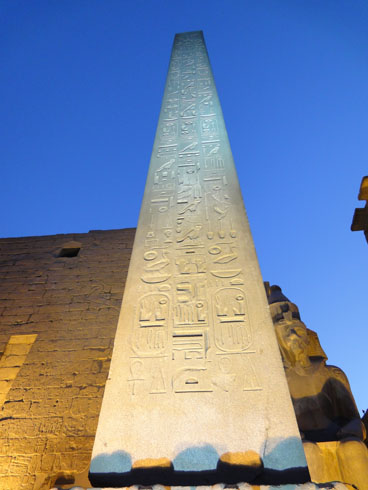
One of the obelisks in the Luxor’s temple
The end: capitulation, return and death toll
After 38 months, the French had to capitulate. The British were too strong. They lost about 13,100 people. They were given 50 days after the capitulation on August 31st, 1801 to leave Egypt. They could return home on British ships and bring with them what they came with and a few manuscripts. The Rosetta Stone would have to go to Britain as well as other antiquities. The French were forbidden to bring the obelisks and statues they hoped to keep. Nevertheless they managed to return with a few mummies.




